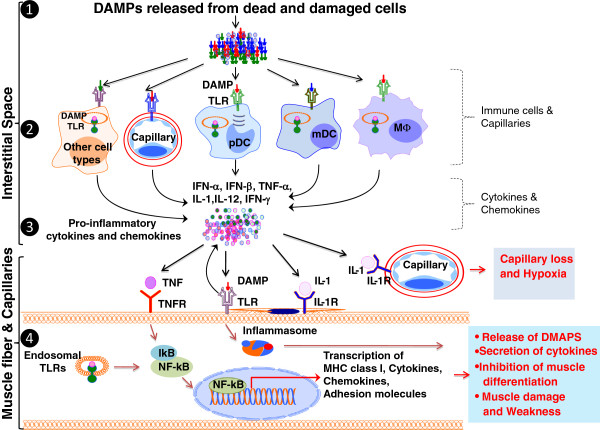Figure 1.
Innate immune mechanisms of muscle damage in myositis. Skeletal muscle undergoes continuous injury and repair in response to a variety of physiological (exercise) and pathological (infection) insults and releases damage-associated molecular patterns (DAMPs) from dead and damaged cells (Step 1). DAMPs initiate innate immune signaling by binding to surface or endogenous TLRs on various cells including skeletal muscle fiber, infiltrating macrophages (Mϕ), myeloid dendritic cells (mDCs), plasmacytoid DCs (pDCs), capillaries, and other cell types such as fibroblasts (Step 2) [4-6]. This innate signaling through TLR and other innate immune receptors induces the secretion of pro-inflammatory cytokines and chemokines [e.g., Type 1 interferons (IFN-α, IFN-β), TNF-α, IL-1, IL-12 and IFN-γ] into the microenvironment (Step 3). These cytokines and DAMPs bind to their respective receptors on muscle and capillaries [e.g., tumor necrosis factor receptor (TNFR), IL-1 receptor (IL-1R)] and exert downstream effects (Step 4) [7-10]. Cytokines and/or chemokines directly cause damage to capillaries and hypoxia in the affected muscle. Cytokines such as TNF-α can directly induce cell death of muscle cells, while NF-kB is known to block MyoD and inhibit formation of the new muscle fibers [11-13]. Thus this pathway not only effectively enhances the death of existing muscle fibers but also inhibits formation of new muscle fibers leading to the loss of skeletal muscle mass and weakness in these disorders.

